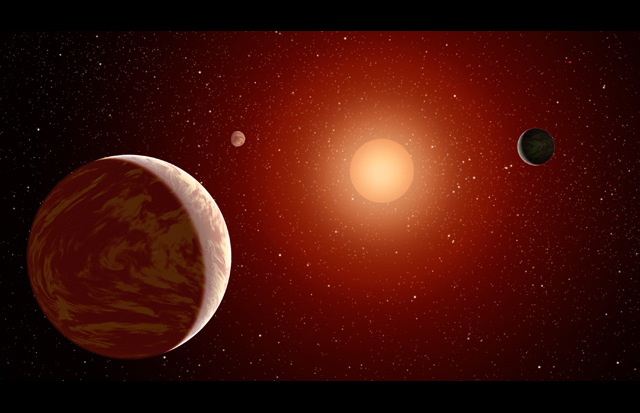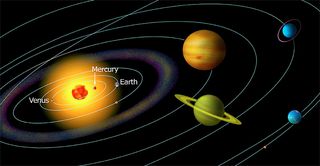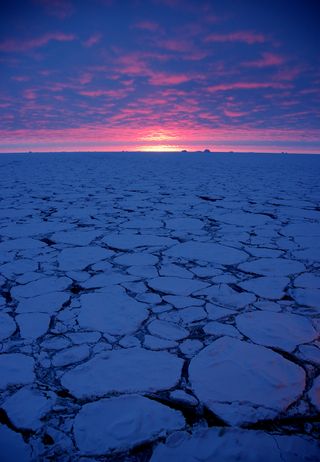Red Dwarf Stars May Be Best Chance for Habitable Alien Planets

Stars known as red dwarfs might have larger habitable zones friendly to ‘life as we know it’ than once thought, researchers say.
Red dwarfs, also known as M stars, are dim compared to stars like our sun and are just 10 to 20 percent as massive. They make up roughly three-quarters of the stars in the galaxy, and recently scientists found red dwarfs are far more common than before thought, making up at least 80 percent of the total number of stars.
The fact that red dwarfs are so very common has made astrobiologists wonder if they might be the best chance for discovering planets habitable to life as we know it. More and more planets are getting discovered around red dwarfs — for instance, a potentially habitable "super-Earth" at least 4.5 times the mass of Earth, GJ 667Cb, was recently found orbiting the red dwarf GJ 667C.
"More of these planets are being found, so research is moving from being theoretical and predictive to using actual data from extrasolar planets," said researcher Manoj Joshi, an atmospheric physicist at the University of East Anglia in England.
The habitable zone of a star is defined by whether liquid water can survive on its surface, given that life exists virtually wherever there is liquid water on Earth. Too far from a star, and a world is too cold, freezing all its water; too close to a star, and a world is too hot, boiling all of its water off. [Vote Now! Strangest Recent Alien Planet Finds]

Since red dwarfs are so cold compared to our sun, planets would have to be very close in to be habitable to any life as we know it — in many cases, less than the distance between Mercury and our sun. This closeness actually makes them appealing to hunters of alien worlds — planets near their stars eclipse them more often, making them easier to detect than planets that orbit farther away.
However, being too close to a star can have its disadvantages. For instance, the gravitational pull of the star would cause tides that could wreak havoc on such a world, perhaps leading to a so-called "tidal Venus" scenario where it loses all of its surface water. Also, young red dwarfs less than 3 billion years old may be very active, firing off flares several times per day, causing ultraviolet radiation to jump by 100 to 10,000 times normal levels and potentially sterilizing the surface of a nearby planet or even helping to strip off its atmosphere.
Get the Space.com Newsletter
Breaking space news, the latest updates on rocket launches, skywatching events and more!
Now scientists find that planets may remain habitable farther away from a red dwarf than once thought. This in turn could mean there is a chance there are far more habitable worlds around red dwarfs than previously suspected.
The habitability of a star depends on how warm or cold it is, which in turn rests in large part on how much starlight it absorbs and reflects. Frozen water such as ice and snow reflects light, which means it helps cool planets, including Earth.
"If a rocky planet forms around an M-star and it has water on it, if it gets cold enough, that'll turn to ice or snow," Joshi said. "As for the odds of rocky planets forming around M-stars, Neptune- and sub-Neptune-sized objects have been found, so chances could be good."

The researchers modeled how reflective ice and snow would be on simulated planets orbiting two real-life red dwarfs. Ice and snow are less reflective against longer, redder wavelengths, while red dwarfs obviously have fairly red light to begin with.
The scientists found that any such planets encircling red dwarf stars would absorb more of their light than previously thought, leading to significantly warmer surfaces. This means the outer edge of the habitable zone around red dwarfs might be 10 to 30 percent farther away from its parent zone than once suggested.
"I was surprised that the effect was as large as it was," Joshi told Astrobiology Magazine. "The zone where liquid water is stable on a planet's surface is farther away from such stars than previously thought."
Joshi cautioned they only looked at the effects of water ice and snow, when other kinds might be important when considering how much energy a planet absorbs and reflects, such as frozen carbon dioxide, nitrous oxide and methane. Also, "we didn't look at the effects of atmospheric absorption of radiation by gases such as water vapor or carbon dioxide," he added. "That should be done in future."
Joshi and Robert Haberle detailed their findings in the Jan. 23 issue of the journal Astrobiology.
This story was provided to SPACE.com by Astrobiology Magazine. Follow SPACE.com for the latest in space science and exploration news on Twitter @Spacedotcom and on Facebook.
Join our Space Forums to keep talking space on the latest missions, night sky and more! And if you have a news tip, correction or comment, let us know at: community@space.com.

Charles Q. Choi is a contributing writer for Space.com and Live Science. He covers all things human origins and astronomy as well as physics, animals and general science topics. Charles has a Master of Arts degree from the University of Missouri-Columbia, School of Journalism and a Bachelor of Arts degree from the University of South Florida. Charles has visited every continent on Earth, drinking rancid yak butter tea in Lhasa, snorkeling with sea lions in the Galapagos and even climbing an iceberg in Antarctica. Visit him at http://www.sciwriter.us
